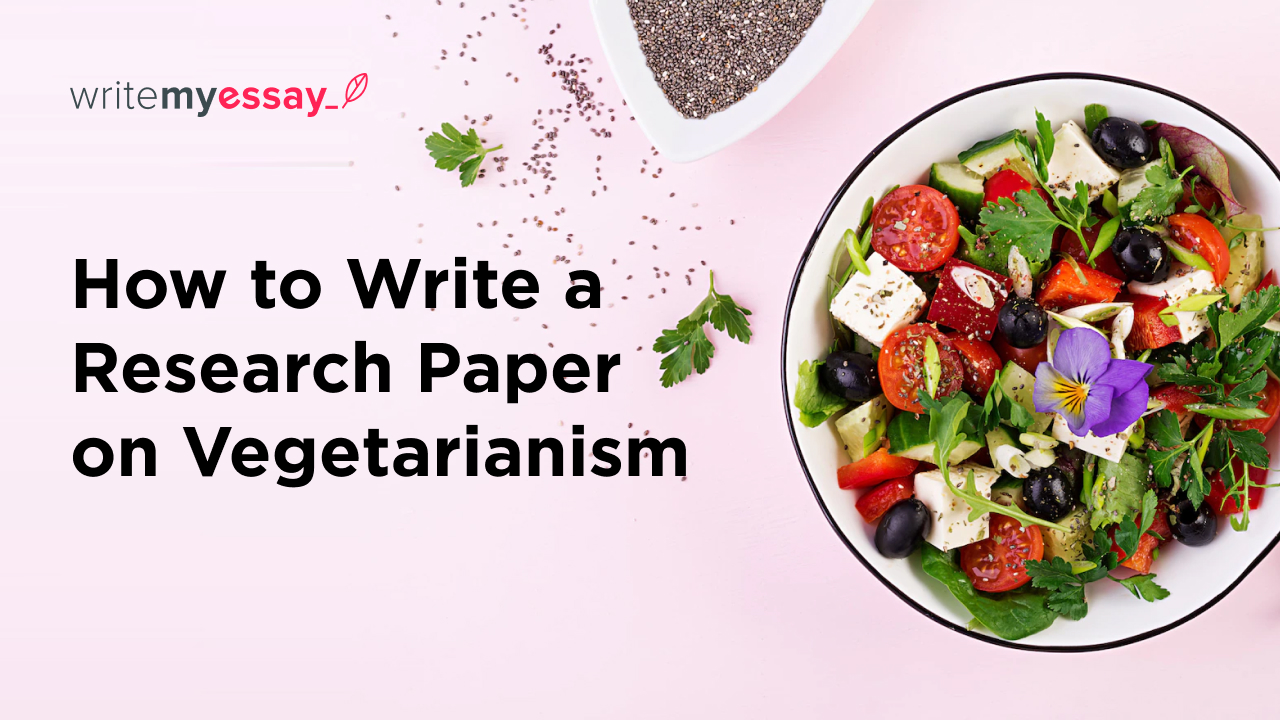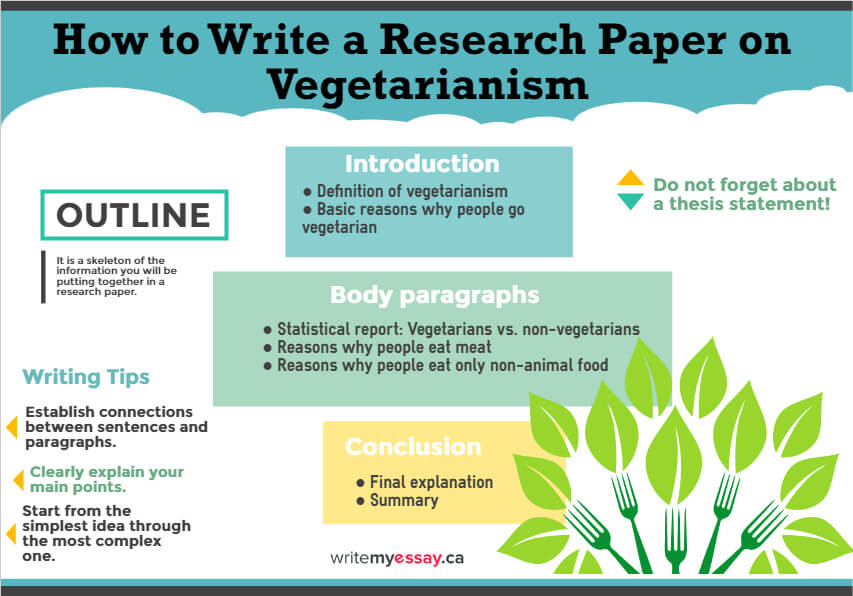
How to Write a Research Paper on Vegetarianism

Table of Contents
Research Paper on Vegetarianism
- How to start
- Example of the outline
- How to write the introduction
- Example of the introduction
- How to write the thesis statement
- Example of the thesis statement
- How to write body paragraphs
- Example of the 1st body paragraph
- Example of the 2nd body paragraph
- Example of the 3rd body paragraph
- How to conclude the research paper
- Example of the conclusion
- Research paper revision
Choosing vegetarianism as your topic for research work is indeed very exciting. It is a controversial topic, to say the least, but it can invoke deep philosophical and social debate. At the outset, it is a movement to let people know about the range of risks of using meat-based diets and their derivatives, relentlessly. On the other hand, it does not stop at merely identifying its point but providing a solution. The solution is polarizing, to say the least, but the overall debate is totally worth it.
This way, students get the chance to have a meaningful debate with people. At the very least, it can educate and entertain them while making a clear point. However, starting your research might be quite a struggle as you might not know what approach you will be using and you might not know how can you show your readers what vegetarianism really is.
Just like other people’s research work, your paper should consist of an introduction, a thesis statement, a strong body, and a conclusion. To serve as an aid, we have created some guidelines for writing a research paper about vegetarianism.
How to start
In starting research, you need to do some basic background study on the topic you have selected. Read all previous studies, essays, and articles similar to what you are planning to write and get an idea. If you already have your objectives, target audience, possible failures, history of your topic, and things you wanted to discuss, you can now proceed in creating your outline. Outline, as defined, is a skeleton of the information you will be putting up together in writing a research. Make it as simple as possible. Below is an example to help you come up with your own one.
Example of the outline
I. INTRODUCTION
- Definition of vegetarianism
- Basic reasons why people go vegetarian
- Thesis Statement
II. BODY PARAGRAPHS
- Statistical report: vegetarians Vs. non-vegetarians
- Reasons why people eat meat
- Reasons why people eat only vegetables and non-animal food
III. CONCLUSION
- Final explanation
- Summary
How to write the introduction
An introduction is a welcome paragraph of your research. It should contain some brief details or what your readers need to expect while they are reading your research. Here, we have listed five tips you should implement to have an excellent introduction:
- Use the word “you” to let your readers feel that the research is dedicated to them.
- Sometimes, starting your introduction with a life quotation related to your research helps.
- You can add the main question you will be answering in the entire research.
- Write your introduction when you have done the whole research.
- Your introduction should have intriguing information; it will make your reader stay and finish reading your research.
How to write the thesis statement
When writing a thesis statement, you should show your exact position to your readers; they should be able to feel where you are coming from. It can be one or two sentences, depending on the length of the whole research work. For example: “Majority of the world’s population eat meat. On the other hand, there are people who really love eating vegetables and simultaneously care about animals. I believe the second group makes the right decision.”
Example of the introduction
Now, let’s try to write an introduction. If you have not tried writing an introduction before, well, you can use this as a basis:
“Vegetables are known as sources of different nutrients that can help us in making our immune system stronger. They can be found everywhere. Aside from the good health benefits they can give, they can even help us in conserving our ecosystem. So, do you think if all of us turn to be a vegetarian and practice the concept of no eating meat, will we have a better world to live in?”
This is only a simple introduction; your creativity and your imagination can help you make it a lot better. Keep in mind that adding a personal touch or human experience to your introduction would let your buyer feel the worth of your research paper.
Organizing the body of your research: Tips on body writing
When it comes to writing your body, make sure you include the main points of your research, the evidence you have gathered, the analysis you have done to understand the problem, and the transition statements that help in making the shifts of your ideas. Mainly, the body serves as the catch-basin of your research; it is where your findings, your ideas, and your data (if you have any) should be placed. Always take care of these things when you write your body:
- Make it simple as possible; a complex and complicated body would make your readers stop reading your research.
- Give proper explanations as to why you come up with those arguments and evidence.
- Do not forget to include the MEAT. No MEAT, no substance.
- Establish connections with the paragraphs.
- Organize your thoughts properly. Start from the simplest idea through the most complex one.
We have created the following three body paragraphs for you to use as a basis.
Example of the 1st body paragraph
“Vegetarianism is the concept of not eating meat but eating purely vegetables. In general, those people who go with this practice want to have a healthier lifestyle. Each vegetarian – a person who follows the practice of vegetarianism, has her own reason for doing this. It can be for animal welfare, for global warming reduction, cancer prevention, and many more. According to research, one out of ten individuals is a vegeterian which is almost 90 percent of the world’s population. This is not an indicator of a beneficial lifestyle. Think of those people who only eat burgers, pizza, pasta, fried chicken, steak and other pre-processed foods. Well, we cannot ask them to stop and change the lifestyle they currently have, it’s their liberty to choose and eat whatever food they want. What we can do is showing them how these kinds of lifestyle shorten their existence.”
Example of the 2nd body paragraph
“There are several reasons why a person does not want to practice vegetarianism. Some of them are just so weird that they will not get enough protein, that plants also have feelings etc. For sure, these are only purely reasons without any acceptable explanation. However, in a more positive way, science says that eating meats are totally fine, it is even part of our food pyramid. In actuality, meats give us proteins, B vitamins, vitamin E, iron, zinc, and magnesium. Yet, a proper balance should always be observed. Remember, all excess gives something negative.”
Example of the 3rd body paragraph
“In contrary to people who hate this lifestyle, we also have those who really love it. They are even committed to not eat meat for their whole life. They are called the vegetarians. These people mostly believe in the benefits vegetable has to offer. But, have they thought that our body also needs meat and other dairy products? Well, for sure they have thought about it. Still, they save animals from killing”
How to conclude the research paper
It is the easiest part; you will only be summarizing whatever you have discussed in the course of your research. This is where you will be answering those questions you have stated and where you will be giving your final say or your recommendations. There are some tips we have included below for you to properly write your conclusion:
- Make it easy to understand, and avoid using highfaluting words.
- Clearly explain your main points.
- Use an indicator to formally inform your readers that your research has been done.
- Make it direct; do not go around the bush!
- Add some worth-remembering lessons.
Example of the conclusion
“In summary, vegetarianism is the concept of not eating meat. It is not important if you are a vegetarian or not. Always keep in mind that everything should go inbalance for a healthy lifestyle.”
Research paper revision
This is the most critical step. In research, your mindset should always be “no room for mistakes”, since you might lose the credibility you earned while your readers read your works. Here are some tips for revisions:
- Let someone read your research; accept whatever recommendations and suggestions they have for you.
- Make sure to not proofread after you write. Rest your eyes and your brain for an hour or more.
- Read your own research, if it sounds right, then it is right.



